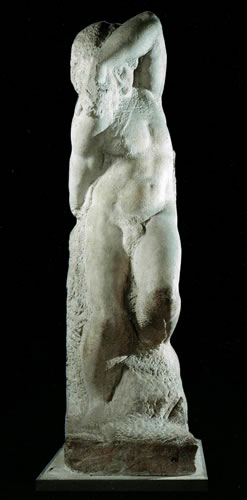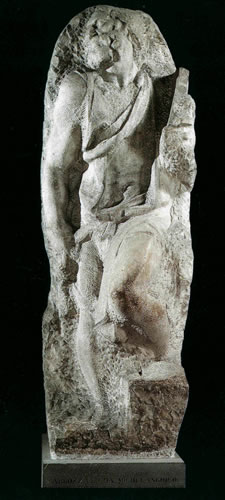 Beyond the Notes:
Beyond the Notes:
Revealed in Stone
The Songs
Read below for the complete texts of the five songs, comments from the composer, and audio excerpts from each movement.
I. Once Hidden and Enclosed
This brief song is the only movement written a cappella (unaccompanied voice), which I chose for dramatic effect. In this poem, unlike any of the others, the speaker appears to be the sculpture itself, which existed inside the marble stone in a mountain and was uncovered by the sculptor--an ongoing theme in Michelangelo's writings. The last line is ambiguous and incomplete, but the original poem really does say "sun" and not "son"!
Listen to the complete song:
Once hidden and enclosed in a great rock,
I came down, against my will, from a great ravine
in the high mountains to this lower place,
to be revealed within this little stone.
When the sun was born, by one whom heaven destines...
[Fragment.]
Michelangelo Buonarroti (1475-1564), translated by James M. Saslow.

II. The Years I Cannot Know
This poem is pre-occupied with the question of time (or lack thereof), and establishes the theme of mortality which will continue to play out in later songs. The music has an underlying ominous quality, which eventually gives way to wonderment at the possibility of "life beyond life".
Listen to an excerpt from the song:
I plan for the time that I will not have
to realize a lofty goal.
I promise myself completion
in the years I cannot know.
But oh, that is a stupid thought!
With death pressing near,
the present slips away
and the future must end.
Meanwhile, I waste my time in yearning.
I hope to heal from the wound of love
so I may enjoy, in death, life beyond life.

III. I Become the Model
Michelangelo uses metaphors of stone and sculpture to illustrate the scenario of the beautiful lady who spurns a pathetic lover.
Listen to an excerpt from the song:
Sometimes one will make
the image of someone else
look like the image of himself.
So, I make her gloomy just as she makes me.
I become the model whenever I model her.
She is as harsh and hard
as the stone in which I sculpt,
yet all I can see within it is myself.
[repeat]
So, I make her gloomy just as she makes me.
I become the model whenever I model her.
Art makes immortal a beauty that passes,
so if she wishes to be eternal
then she must make me happy
so I can make her beautiful!
IV. Hidden in You
While Michelangelo is able to draw great works from the marble, he is unable to achieve the same with his lady. I see the first stanza of this poem as a wonderful miniature manifesto, encapsulating Michelangelo's idea of sculpture as the act of revealing what was already present in the stone.
Listen to an excerpt from the song:
The best of artists has no conception
that the marble does not already contain.
But that is only attained by
the hand that obeys the intellect.
The pain that I flee and the joy that I seek
are also hidden in you, divine lady;
but it brings me death that my art
denies my wishes.
Do not blame for my pain
your beauty and your scorn,
or my misfortune or fate.
Since your heart contains both
death and mercy, but my poor skill
draws from your heart only death.

V. A Thousand Years After We Are Gone
The cycle culminates with Michelangelo's declaration that while immortality cannot be attained by living beings, painting and sculpture allow us the possibility of "extending our lifetimes."
Listen to an excerpt from the song:
How can it be, Lady, as anyone can see
from experience,
that the living image sculpted in hard alpine stone
lives longer than its maker,
who will turn to ashes.
Cause yields to the effect,
and nature is ruled by art.
I know, because I carve beautiful statues
that time and death do not affect.
So I can extend our lifetimes,
whether in colors or stone,
by replicating faces, yours and mine.
So that a thousand years after we are gone
all can see how lovely you were,
and how pathetic I was,
and that I was no fool in loving you.
Michelangelo Buonarroti (1475-1564), adapted by Nell Shaw Cohen from English translations by James M. Saslow and Sidney Alexander.